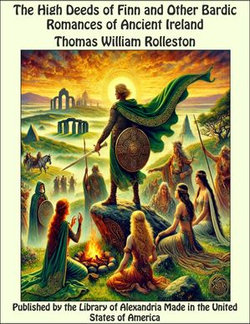As to the stories themselves, they have certain well-marked characteristics, and in dwelling on these, I shall chiefly refer, for illustration, to the stories in this book. Some of these characteristic elements belong to almost all mythological tales, and arise from human imagination, in separated lands, working in the same or in a similar way on the doings of Nature, and impersonating them. The form, however, in which these original ideas are cast is, in each people, modified and varied by the animal life, the climate, the configuration of the country, the nearness of mountain ranges and of the sea, the existence of wide forests or vast plains, of swift rivers and great inland waters. The earliest tales of Ireland are crowded with the sea that wrapt the island in its arms; and on the west and north the sea was the mighty and mysterious Ocean, in whose far infinities lay for the Irish the land of Immortal Youth. Between its shining shores and Ireland, strange islands—dwelt in by dreadful or by fair and gracious creatures, whose wonders Maeldun and Brendan visited—lay like jewels on the green and sapphire waters. Out of this vast ocean emerged also their fiercest enemies. Thither, beyond these islands into the Unknown, over the waves on a fairy steed, went Oisín with Niam; thither, in after years, sailed St Brendan, till it seemed he touched America. In the ocean depths were fair cities and well-grassed lands and cattle, which voyagers saw through water thin and clear. There, too, Brian, one of the sons of Turenn, descended in his water-dress and his crystal helmet, and found high-bosomed maidens weaving in a shining hall. Into the land beneath the wave, Mananan, the proud god of the sea brought Dermot and Finn and the Fianna to help him in his wars, as is told in the story of the Gilla Dacar. On these western seas, near the land, Lir's daughters, singing and floating, passed three hundred years. On other seas, in the storm and in the freezing sleet that trouble the dark waves of Moyle, between Antrim and the Scottish isles, they spent another three centuries. Half the story of the Sons of Usnach has to do with the crossing of seas and with the coast. Even Cuchulain, who is a land hero, in one of the versions of his death, dies fighting the sea-waves. The sound, the restlessness, the calm, the savour and the infinite of the sea, live in a host of these stories; and to cap all, the sea itself and Mananan its god sympathise with the fates of Erin. When great trouble threatens Ireland, or one of her heroes is near death, there are three huge waves which, at three different points, rise, roaring, out of the ocean, and roll, flooding every creek and bay and cave and river round the whole coast with tidings of sorrow and doom. Later on, in the Fenian tales, the sea is not so prominent. Finn and his clan are more concerned with the land. Their work, their hunting and adventures carry them over the mountains and plains, through the forests, and by the lakes and rivers. In the stories there is scarcely any part of Ireland which is not linked, almost geographically, with its scenery. Even the ancient gods have retired from the coast to live in the pleasant green hills or by the wooded shores of the great lakes or in hearing of the soft murmur of the rivers. This business of the sea, this varied aspect of the land, crept into the imagination of the Irish, and were used by them to embroider and adorn their poems and tales. They do not care as much for the doings of the sky. There does not seem to be any supreme god of the heaven in their mythology. Neither the sun nor the moon are specially worshipped. There are sun-heroes like Lugh, but no isolated sun-god.



Share This eBook: